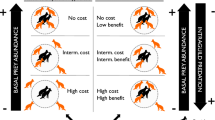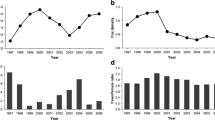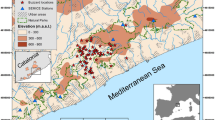Abstract
Predation directly changes the demographics of prey, generally through a numerical decrease. An indirect effect of predators is alteration of movements and spatial patterns of prey. The relationship between these direct and indirect effects can be tested by excluding predators. Home range size of white-footed mice (Peromyscus leucopus) decreased and home range overlaps increased in the absence of predators. Home range size and overlaps of meadow voles (Microtus pennsylvanicus) did not change despite an increase in vole density. P. leucopus had significantly lower interspecific home range overlaps with M. pennsylvanicus than intraspecific overlaps. The changes in P. leucopus spatial behavior may be an indirect effect of predator exclusion resulting from the increase in M. pennsylvanicus densities.





Similar content being viewed by others
References
Abramsky Z, Tracy CR (1980) Relation between home range size and regulation of population size in Microtus ochrogaster. Oikos 34:347–355
Abramsky Z, Dyer MI, Harrison D (1979) Competition among small mammals in experimentally perturbed area of the shortgrass prairie. Ecology 60:530–536
Boulanger JG, White GC (1990) A comparison of home-range estimators using Monte Carlo simulation. J Wildl Manage 54:310–315
Brown JS (1989) Desert rodent community structure: a test of four mechanisms of coexistence. Ecol Monogr 59:1–20
Cochran GR, Solomon NG (2000) Effects of food supplementation on the social organiztion of prairie voles (Microtus ochrogaster). J Mammal 81:746–757
Conventry AF (1937) Notes on the breeding of some Cricetidae in Ontario. J Mammal 18:489–496
Cooper D (1997) Foraging responses of the Great-horned Owl (Bubo virginianus) to changes in prey abundance. MS thesis, Northern Illinois University, Ill.
Day RW, Quinn GP (1989) Comparisons of treatments after an analysis of variance in ecology. Ecol Monogr 59:433–453
Desy EA, Batzli GO, Liu J (1990) Effects of food and predation on behavior of prairie voles: a field experiment. Oikos 58:159–168
DeWitt TJ, Sih A, Hucko JA (1999) Trait compensation and cospecialization in a freshwater sail: size, shape, and antipredator behavior. Anim Behav 58:397–407
Dueser RD, Wilson MD, Rose RK (1981) Attributes of dispersing meadow voles in open grid populations. Acta Theriol 26:139–162
Dueser RD, Rose RK, Porter JH (1984) A body-weight criterion to identify dispersing small mammals. J Mammal 65:727–729
Endler JA (1987) Predation, light intensity and courtship behavior in Poecilia reticulata (Pisces, Poeciliidae). Anim Behav 35:1376–1385
Erlinge S, Goransson G, Hansson L, Hogstedt G, Liberg O, Nilsson NI, Nilsson T, von Schantz T, Sylven M (1983) Predation as a regulatory factor on small rodent populations in southern Sweden. Oikos 40:36–52
Gaines MS, Johnson ML (1982) Home range size and population dynamics in the prairie vole, Microtus ochrogaster. Oikos 39:63–70
Getz LL (1961) Home ranges, territoriality and movement of the meadow vole. J Mammal 42:24–36
Getz LL, Carter CS (1980) Social organization in Microtus ochrogaster populations. Biologist 62:56–59
Getz LL, Solomon NG, Pizzuto TM (1990) The effects of predation of snakes on social organization of the prairie vole, Microtus ochrogaster. Am Midl Nat 123:365–371
Gilliam JF, Fraser DF, Sabat AM (1989) Strong effects of foraging minnows on a stream benthic invertebrate community. Ecology 70:445–452
Gorman ML (1984) The response of prey to stoat (Mustela erminea) scent. J Zool (Lond) 202:419–423
Gottschang JL (1956) Juvenile molt in Peromyscus leucopus noveboracensis. J Mammal 37:516–520
Grant PR (1971) Experimental studies of competitive interaction in a two-species system. III. Microtus and Peromyscus species in enclosures. J Anim Ecol 40:323–350
Hestbeck JB (1982) Population regulation of cyclic mammals: the social fence hypothesis. Oikos 39:157–163
Hestbeck JB (1988) Population regulation of cyclic mammals: a model of the social fence hypothesis. Oikos 52:156–168
Hoffmeister DE (1989) Mammals of Illinois. University of Illinois Press, Champagne, Ill.
Hooge PN, Eichenlaub B (2000) Animal movement extension to ArcView, ver. 2.0. Alaska Science Center—Biological Science Office, U.S. Geological Survey, Anchorage, Alaska
Huffaker CB, Berryman AA, Laing JE (1984) Natural control of insect population. In: Huffaker CB, Rabb RL (eds) Ecological entomology. Wiley, New York, pp 359–385
Hurlbert SH (1984) Pseudoreplication and the design of ecological field experiments. Ecol Monogr 54:187–211
Illinois Natural History Survey (1985) Evaluation and recommendations concerning biological assessments of habitats and related endangered, threatened, and federally proposed flora and fauna of Fermi National Accelerator Laboratory. Final report. Champaign, Ill.
Jaksic FM, Meserve PL, Gutiérrez JR, Tabilo E (1993) The components of predation on small mammals in semiarid Chile: preliminary results. Rev Chil Hist Nat 66:305–321
Jandel Scientific (1988) SigmaScan, version 1.10. Corte Madera, Calif.
Kotler BP, Blaustein L, Brown JS (1992) Predator facilitation: the combined effects of snakes and owls on the foraging behavior of gerbils. Ann Zool Fenn 29:199–206
Krebs CJ, Keller BL, Tamarin RH (1969) Microtus population biology: demographic changes in fluctuating populations of Microtus ochrogaster and M. pennsylvanicus in southern Indiana. Ecology 50:587–607
Lagos VO, Contreras LC, Meserve PL, Gutiérrez JR, Jaksic FM (1995) Predation effects on space use by small mammals: a field experiment with a Neotropical rodent, Octodon degus. Oikos 74:259–264
Larkin RP, Halkin D (1994) A review of software packages for estimating animal home ranges. Wildl Soc Bull 22:274–287
Layne JN (1968) Ontogeny. In: King JA (ed) Biology of Peromyscus (Rodentia). Am Soc Mammal Spec Publ 10:451–495
Le Boulengé E (1987) Package CMR user’s guide. Université Catholique de Louvain, Louvain la Neuve, Belgium
Lima SL, Dill LM (1990) Behavioral decisions made under the risk of predation: a review and prospectus. Can J Zool 68:619–640
Littell RC, Freud RJ, Spector PC (1991) SAS system for linear models. SAS Institute, Cary, N.C.
Longland WS, Price MV (1991) Direct observation of owls and heteromyid rodents: can predation risk explain microhabitat use? Ecology 72:2261–2273
Macdonald DW (1980) Patterns of scent marking with urine and faeces amongst carnivore communities. Symp Zool Soc (Lond) 45:107–139
Madison D (1980) Space use and social structure in meadow voles, Microtus pennsylvanicus. Behav Ecol Sociobiol 7:65–71
Maza BG, French NR, Aschwanden AP (1973) Home range dynamics in a population of heteromyid rodents. J Mammal 54:405–425
McCravy KW, Rose RK (1992) An analysis of external features as predictors of reproductive status in small mammals. J Mammal 73:151–159
Meserve PL, Gutiérrez J, Jaksic FM (1993) Effects of vertebrate predators on a caviomorph rodent, the degus (Octodon degus), in a semiarid thorn scrub community in Chile. Oecologia 94:153–158
Meserve PL, Gutiérrez JR, Yunger JA, Contreras LC, Jaksic FM (1996) Role of biotic interactions in a small mammal assemblage in semiarid Chile. Ecology 77:133–148
Nadeau JH (1985) Ontogeny. In: Tamarin RH (ed) Biology of New World Microtus. Am Soc Mammal Spec Publ 8:254–285
Ostfeld RS (1994) The fence effect reconsidered. Oikos 70:340–348
Ostfeld RS, Pugh SR, Seamon JO, Tamarin RH (1988) Space use and reproductive success in a population of meadow voles. J Anim Ecol 57:385–394
Petticrew BG, Sadleir RMFS (1974) The ecology of the deer mouse Peromyscus maniculatus in a coastal coniferous forest I. Population dynamics. Can J Zool 52:107–118
Pollock KH, Nichols JD, Bownie C, Hines JE (1990) Statistical inference for capture–recapture experiments. Wildl Monogr 107:1–97
Power ME (1987) Predator avoidance by grazing fishes in temperate and tropical streams: importance of stream depth and prey size. In: Kerfoot WC, Sih A (eds) Predation: direct and indirect impacts on aquatic communities. University Press of New England, Hanover, N.H., pp 333–351
Randa LA (1996) Prey selectivity and foraging activity of Canis latrans and Vulpes vulpes in response to prey fluctuations in a heterogeneous landscape. MS thesis, Northern Illinois University, Ill.
Redfield JA, Krebs CJ, Taitt MJ (1977) Competition between Peromyscus maniculatus and Microtus townsendii in grasslands of coastal British Columbia. J Anim Ecol 46:607–616
Ribble DO, Wurtz AE, McConnell EK, Buegge JJ, Welch KC (2002) A comparison of home ranges of two species of Peromyscus using trapping and radiotelemetry data. J Mammal 83:260–266
Riechert SE, Bishop L (1990) Prey control by an assemblage of generalist predators: spiders in garden test systems. Ecology 71:1441–1450
Ruxton G, Armstrong JD, Humphries S (1999) Modeling territorial behavior of animals in variable environments. Anim Behav 58:113–120
SAS Institute (1990a) SAS/STAT user’s guide, version 6, vol 2, 4th edn. Cary, N.C.
SAS Institute (1990b) SAS/STAT user’s guide, version 6, vol 1, 4th edn. Cary, N.C.
Seber GAF (1982) The estimate of animal abundance and other related parameters. Griffin, London
Sih A (1988) The effect of predators on habitat use, activity and mating behavior in a semi-aquatic bug. Anim Behav 36:1846–1848
Sih A, Crowely P, McMeek M, Petranka J, Strohmeier K (1985) Predation, competition, and prey communities: a review of field experiments. Annu Rev Ecol Syst 16:269–311
Smith AT, Ivins BL (1983) Colonization in a pika population: dispersal vs. philopatry. Behav Ecol Sociobiol 13:37–47
Stickel L (1954) A comparison of certain methods of measuring ranges of small mammals. J Mammal 35:1–15
Stoddart DM (1976) Effect of the odour of weasels (Mustela nivalis L.) on trapped samples of their prey. Oecologia 22:439–441
Sullivan TP, Crump DR, Sullivan DS (1988) Use of predator odors as repellents to reduce damage by herbivores. III. Montane and meadow voles (Microtus montanus and Microtus pennsylvanicus). J Chem Ecol 14:363–377
Tamarin RH (1984) Body mass as a criterion of dispersal in voles: a critique. J Mammal 65:691–692
Van Vleck DB (1969) Standardization of Microtus home range calculation. J Mammal 50:69–80
Wirtz WO, Pearson PG (1960) A preliminary analysis of habitat orientation in Microtus and Peromyscus. Am Midl Nat 63:131–142
Wolff JO (1997) Population regulation in mammals: an evolutionary perspective. J Anim Ecol 66:1–13
Wolff JO, Lundy KI, Baccus R (1988) Dispersal, inbreeding avoidance and reproductive success in white-footed mice. Anim Behav 36:456–465
Ylönen J, Magnhagen C (1992) Predation risk and behavioral adaptations of prey: ecological and evolutionary consequences. Symposium proceedings. Ann Zool Fenn 29
Yunger JA (1996) Population dynamics of small mammals. PhD thesis, Northern Illinois University, Ill.
Yunger JA (2001) Response of two low-density populations of Peromyscus leucopus to increased food availability. J Mammal 83:267–279
Yunger JA, Meserve PL, Gutierrez JR (2002) Small-mammal foraging behavior: mechanisms for coexistence and implication for population dynamics. Ecol Monogr 72:561–577
Zar JH (1984) Biostatistical analysis. Prentice-Hall, Englewood Cliffs, N.J.
Acknowledgements
I am grateful to Dr. Peter Meserve who provided continuous and diverse support throughout this investigation. Special thanks goes to Lynda Randa for untiring assistance in the field and support with both research and making graduate school enjoyable. Peter Meserve, Ed Miller, and Lynda Randa offered valuable comments that helped improve the manuscript. Doug Cooper, Victor Lagos, and John Bell provided valuable field assistance. Bruce Patterson, Sam Scheiner, Paul Sörensen, and Carl von Ende provided support and advice during the design, implementation, and synthesis of the research. Fifteen undergraduate students, in particular Cara Joos, assisted with a variety of different field and laboratory aspects of the investigation. Rod Walton coordinated activity with Fermilab and helped obtain funding and establish a permanent field site. Funding for this project was provided by the Department of Energy (MO-RS023), Sigma Xi, the Department of Biological Sciences, Northern Illinois University, the Graduate School, Northern Illinois University, and the Environmental Biology Program, Governors State University. All research was approved by the Animal Care and Use Committee; state permits were obtained for the trapping.
Author information
Authors and Affiliations
Corresponding author
Rights and permissions
About this article
Cite this article
Yunger, J.A. Movement and spatial organization of small mammals following vertebrate predator exclusion. Oecologia 139, 647–654 (2004). https://doi.org/10.1007/s00442-004-1534-2
Received:
Accepted:
Published:
Issue Date:
DOI: https://doi.org/10.1007/s00442-004-1534-2




